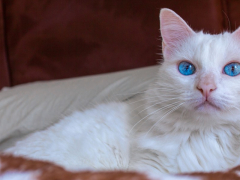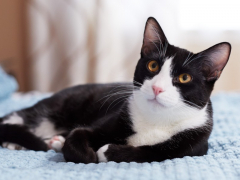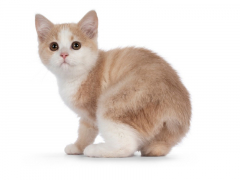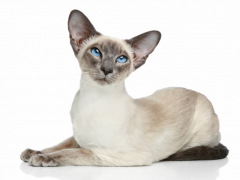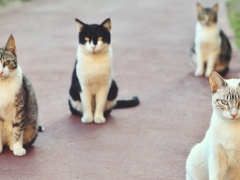
Photo credit: Paulmcsorley, CC BY-SA 3.0 <https://creativecommons.org/licenses/by-sa/3.0>, via Wikimedia Commons
The Minskin cat is a relatively new cat breed, created in 1998 and still evolving. The foundation cats for the Minskin were crossbred Burmese and Munchkin cats, as well as the hairless Sphynx cat and Devon Rex. The Burmese is a short-haired cat related to the Siamese cat, and the Munchkin is a dwarf breed characterized by extremely short legs.
The Minskin is a small, stocky cat with a round head, semi-cobby body, and short legs. They can be any color or pattern, but must always have fur points (denser areas of soft fur). Minskin cats have a friendly, affectionate temperament, and enjoy being held.
Also Read: Cat Anatomy Guide
Here are 12 fun facts you might not know about the adorable Minskin cat.
1. The Minskin Is Not Hairless
Although the Sphynx, a hairless cat, is one of the foundation breeds for the Minskin, the Minskin cat is not completely hairless. Minskins have short, soft coats that feel like cashmere.
Fur points are an important part of the Minskin breed standard. These are areas of denser hair that appear in the same places where color points are found in the Siamese and related breeds. On the Minskin, the fur points are found on the face, ears, legs, and tail. Minskins sometimes appear to be bald on the neck, chest, and belly, but these areas are in fact covered with a very soft, downy fur.
2. They Are a New Breed
It is still early in the development of the breed, and the breed has not yet been fully accepted by a governing cat registry such as The International Cat Association (TICA) or the Cat Fanciers’ Association (CFA). In 2008, TICA designated the Minskin as a preliminary new breed of cat, but the breed was switched to registration only in 2019. Minskin kittens can be registered with TICA, but Minskins cannot compete in shows for championship titles.
3. The Minskin Was Born From One Man’s Vision
Cat breeder Paul McSorley of TRT Cattery, who lived in Boston, Massachusetts, had been outcrossing Burmese to Munchkin cats. As well as these established cat breeds, he also became interested in the hairless Sphynx.
McSorley noticed that the “fuzzy” Sphynx with fur points seemed healthier than their bald littermates, and he began dreaming of a new breed. He envisioned a cat with the short legs of the Munchkin and the sparse coat and fur points found in some Sphynx and Devon Rex cats, so he introduced those two breeds to his established Burmese/Munchkins, and the Minskin was born.
4. They Are Extremely Rare
Because the breed is still under development, the Minskin cat is very rare, with only a small number of people breeding Minskins in the United States and Canada. The breed founder, Paul McSorley, is still actively breeding Minskins.
5. Minskins Look Like Kittens, Even in Adulthood
A full grown Minskin cat usually weighs between 4 to 9 pounds. Non-standard Minskins with longer legs might weigh more than standard Minskins with short legs. People often mistake adult standard Minskins for kittens. This perpetual kitten-like appearance is in part due to their short legs, but also due to the Minskin’s large, round head; large, round eyes set wide apart, and their sweet personality.
6. Their Name Honors Their Appearance
The “Min” part of the breed name refers to the breed’s miniature legs, which came from the Munchkin cat, a dwarf breed. The “skin” part of the breed name is in reference to the breed’s unique rexed hair coat, which lies close to the skin and is very sparse—in some places, so fine and downy that it appears as if the cat is hairless.
7. Minskin Cats Are Very Loving
More than just adorable in looks, Minskin cats have some sweet personality traits. They are exceptionally sweet, intelligent and engaging cats. These friendly felines get along with most people, including gentle children, and also tend to get along with other cats and even dogs. They are outgoing, playful, and people-oriented – and love to give affection to their cat parents. In fact, they don’t do well when left alone, so this is not the best breed for people who are away from home a lot.
8. They Don’t Shed Much Hair
The sparse, rexed coat of standard Minskins doesn’t leave much hair around the house. Some Minskins don’t shed at all, and for others, shedding is very minimal. No cat is 100% hypoallergenic, but some people who suffer from cat allergies find that they can live comfortably with a Minskin kitty.
Although standard Minskin cats don’t need brushing, you can wipe them down occasionally with a soft cloth. Like their Sphynx cousins, Minskins benefit from a bath with a moisturizing shampoo every one to three weeks. It’s important to examine a Minskin’s ears at least weekly and clean with a pet-safe ear cleanser when they become dirty. Daily teeth brushing is the gold standard for at-home dental care.
Also Read: How To Give A Cat A Bath
9. Minskins Are Expensive
Due to their novel nature, Minskins are rare and difficult to source – due to their rising popularity, you may well need to join a wait list with a reputable breeder. This also means their cost is quite high – around $2500. As they gain in popularity, their price tag may adapt to be more in line with other pedigree cat breeds.
10. They Are Generally Healthy
As a breed, the Minskin is generally healthy, although they have the potential to inherit certain genetically linked breed disorders and health issues found in the four parent breeds (the Burmese, Munchkin, Sphynx and Devon Rex). Breeders commonly test and evaluate their adult cats for hypertrophic cardiomyopathy prior to breeding them to avoid passing on this heart condition.
Minskin cats share the same genetic mutation as their relatives, Munchkin cats, which causes shortened limbs. You may think that they may have trouble getting around, but this couldn’t be further than the truth. Like their relative the Munchkin, Minskins are active and able to run, jump, and climb with ease, though they might not explore quite as high as cats with longer legs. However, this genetic defect can be linked to some chronic health problems, such as osteoarthritis.
11. Minskins Like Warm Places
That sparse hair coat means Minskins are rarely too hot. In fact, they seem to seek out warm places, whether on your lap or under the covers. A Minskin is often a welcome cuddle partner because they feel warm like a hot water bottle.
In winter time, some Minskins appreciate a warm sweater to keep them cozy. Their sparse coats don’t provide much protection from the sun or elements, so Minskins should live indoors. If your Minskin cat wants to sunbath near a window or door, apply a pet-safe sunscreen to protect their sensitive skin.
12. They Can Have Long Legs and Full Hair Coats
Not all Minskin kittens are born with short legs and the trademark sparse rexed coat with fur points. Some Minskins are considered non-standard. These non-standard Minskins might be born with long legs.
Non-standard Minskins can also be born completely hairless (without the rexed sparse coat and without fur points) or they can have a short, straight coat much like a domestic shorthaired cat. Non-standard Minskin kittens still have the wonderful personality and adorable, kitten-like looks of the Minskin breed.
Final Thoughts
The Minskin cat is a unique new breed known for its short legs and sparse, rexed coat with fur points. Although the Minskin has already won over the hearts of many cat lovers, the breed is still under development rather than an official breed, so it cannot yet complete in cat shows. The Minskin is rare with only a small number of reputable breeders, so potential kitten buyers should be prepared to join a wait list.
Also Read: New Cat Owner Anxiety: Why It Happens & How To Overcome It
